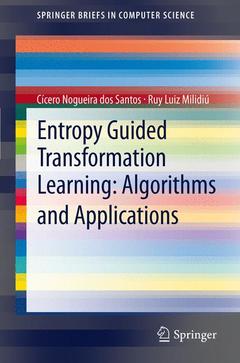Description
Entropy Guided Transformation Learning: Algorithms and Applications, 2012
SpringerBriefs in Computer Science Series
Authors: dos Santos Cícero Nogueira, Milidiú Ruy Luiz
Language: English
Approximative price 52.74 €
In Print (Delivery period: 15 days).
Add to cart78 p. · 15.5x23.5 cm · Paperback
Description
/li>Contents
/li>Comment
/li>
Entropy Guided Transformation Learning: Algorithms and Applications (ETL) presents a machine learning algorithm for classification tasks. ETL generalizes Transformation Based Learning (TBL) by solving the TBL bottleneck: the construction of good template sets. ETL automatically generates templates using Decision Tree decomposition.
The authors describe ETL Committee, an ensemble method that uses ETL as the base learner. Experimental results show that ETL Committee improves the effectiveness of ETL classifiers. The application of ETL is presented to four Natural Language Processing (NLP) tasks: part-of-speech tagging, phrase chunking, named entity recognition and semantic role labeling. Extensive experimental results demonstrate that ETL is an effective way to learn accurate transformation rules, and shows better results than TBL with handcrafted templates for the four tasks. By avoiding the use of handcrafted templates, ETL enables the use of transformation rules to a greater range of tasks.
Suitable for both advanced undergraduate and graduate courses, Entropy Guided Transformation Learning: Algorithms and Applications provides a comprehensive introduction to ETL and its NLP applications.
Preface.- Acknowledgements.- Acronyms.- Part I Entropy Guided Transformation Learning: Algorithms.- Introduction.- Entropy Guided Transformation Learning.- ETL Committee.- Part II Entropy Guided Transformation Learning: Applications.- General ETL Modeling for NLP Tasks.- Part-of-Speech Tagging.- Phrase Chunking.- Named Entity Recognition.- Semantic Role Labeling.- Conclusions.- Appendices.
Detailed explanation of the Entropy Guided Transformation Learning algorithm
Detailed explanation of how to create ensembles of ETL classifiers
Explains how to apply ETL to four NLP problems
Includes supplementary material: sn.pub/extras

